| Steve Ihnat, a Czechoslovakian-born Canadian who emigrated to the United States in 1958, became one of the most popular guest-stars on 1960s TV, with appearances in multiple episodes of some of the top series of the decade: Mission Impossible, Mannix, Gunsmoke and Bonanza, and memorable appearances in other series as well, before his untimely death at age 37 from a heart attack, in 1972.
As far as science fiction TV is concerned, he had only three appearances. In 1964, he had a cameo role as a doomed Antarctic scientist in Voyage to the Bottom of the Sea's first "monster" episode, "The Price of Doom."
Later on that year he starred as the mind-controlled Lieutenant Minns in a two-parter for The Outer Limits, "The Inheritors," working opposite Robert Duvall. |
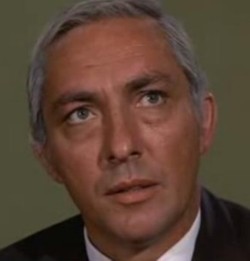
Steve Ihnat as Stefan Miklos in "The Mind of Stefan Miklos" episode of Mission Impossible (1969) |
And in 1969, Steve had a star turn as Garth of Izar in the third-season Star Trek episode, "Whom God's Destroy."
Although Steve appeared in eleven movies, success eluded him in that sphere, and in most of them he was relegated to minor supporting roles. This was true in the case of his turn as the villainous General Carter in In Like Flint (1967) starring James Coburn. However, he gets more screen time in Robert Altman's tale of the space race, Countdown (1968), in which he worked again with Robert Duvall.
We examine those roles in this article. (For Ihnat's non-SF ouvre, check out: Brief Candle: A Tribute to Steve Ihnat).
The Young Actor
Steve grew up on a farm in a very small town in Canada, and began dreaming of being an actor at age 14. He arrived in the United States in 1958, and enrolled in acting classes at the Pasadena Playhouse. There, he met and became friends with many up-and-coming actors, such as Dustin Hoffman, Robert Duvall and Gary Clarke. Indeed, he and Clarke would appear in several low budget movies from 1958 onward. In one of these, Strike Me Deadly, Steve co-wrote the script with director/producer Ted Mikels, and played the villain.
Steve had a handful of guest-starring roles on TV from 1959-1963 (although he enlisted in the US Army and spent from 1960 to 1962 in Korea). Upon his return, his career really began to take off in 1964, when he guest-starred on six TV series. He had roles in episodes of Channing (drama about a high school teacher), Death Valley Days, (Western anthology), Slattery's People (small-town poltical drama) and Dr. Kildare (medical drama).
Then came VTTBOTS.
Voyage to the Bottom of the Sea (1964)
 |
Irwin Allen's film Voyage to the Bottom of the Sea (1961) starred Walter Pidgeon as Admiral Nelson and Robert Serling as Captain Lee Crane. When Allen brought the movie to the small screen in 1964, Richard Basehart became Nelson, and David Hedison Crane.
The series ran for four seasons. The first season, aired in 1964, dealt with Cold War politics, and criminals, and generally had a pretty serious tone, aimed at a mature audience. The network requested that this tone become more light-hearted, and so subsequent seasons had more "monsters of the week" science fiction stories and a more juvenile feel.
The first season did have a couple of overtly science-fictional episodes. The first "monster" episode ever was the fifth one, "The Price of Doom," which aired on October 12, 1964. The "monster" as created by Harlan Ellison, was man-eating plankton. (Other writers changed the plot in ways Ellison didn't like, so he had his name removed and used the Cordwainer Bird alias.) |
James Goldstone directed Steve in his cameo role. Pat Priest, who played his wife, would go on to play Marilyn in The Munsters.
Summary
Husband and wife scientists, the Pennels, stationed in the Antarctic, have discovered a new strain of plankton. A magnetic storm prevents them from contacting the Seaview. Mrs. Pennel brings some auxiliary heaters into the room before going to sleep. The extra-heat idea was bad, very bad.
  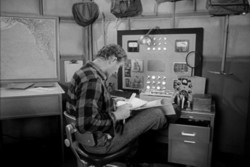
Oblivious to the plankton growing, and growing, and growing, Dr. Pennel tapes his report on their experiments with the plankton. Then he hears a chair knocked over and a scream from his wife. He turns.
 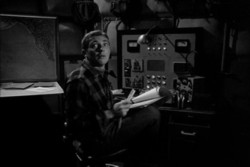 
Pennel sees the plankton attacking his wife. He rushes to her assistance, but is unable to pull her free. Then he is engulfed himself. At the last, knowing the recorder is still going, he screams, "It's the plankton, it's the plankton!" in what will turn out to be a futile effort to keep the Seaview from bringing the deadly menace on board.
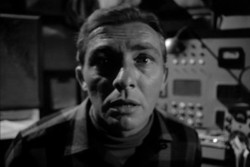 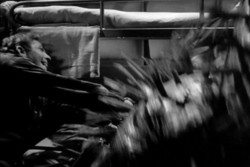 
The Outer Limits
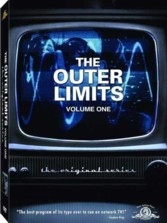 |
The Twilight Zone (1959-1964) is generally considered the most influential science fiction anthology series of all time. This is the series that is in syndication, and which generally has marathons run for it on every major holiday. If you want to see The Outer Limits, you've got to buy the DVDs or individual episodes (at Amazon Unbox) or watch the episodes at Hulu.com.
The Outer Limits made its debut in 1963, and ran for a total of 49 episodes over two seasons, with the last episode broadcast in 1965.
The first season of The Outer Limits is generally considered by fans to be the best in the series' two year existence, with a lot of "bears" as the crewpeople called them - aliens to the audience at home.
Harlan Ellison contributed a couple of scripts to this series in the second season -- "Demon With a Glass Hand," which starred Robert Culp, and "Soldier," which starred Michael Ansara. |
Future Star Trek actors William Shatner, Leonard Nimoy, James Doohan and Grace Lee Whitney appeared in episodes of this series.
"The Inheritors" had no alien monsters, but was rather an exercise in suspense. Who has taken over the minds of four men, and what is their sinister plan? Will they be able to be stopped in time?
The episide was written by Seeleg Lester and Samuel Neuman. It was directed by James Goldstone.
Indeed, Goldstone directed several episodes of this series, and perhaps it was he who suggested to the casting director that Steve Ihnat test for the role of Lietenant Minns, as he'd just worked with him on VTTBOTS.
Robert Duvall is the star of this two-parter, and received top billing. Indeed, in the opening credits, Ihnat's name isn't even mentioned.
Summary
Lieutenant Minns, somewhere in Korea, is conducting a solo recce, is shot in the head. Cut to an operating room, where doctors battle to save his life while an intense Ballard (Robert Duvall) looks on.
  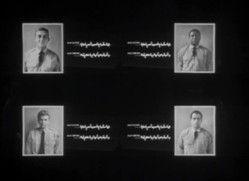
Ballard reveals to his superior than four men have now been shot with bullets made from a meteorite fragment. Each of them has developed genius-level IQs. Three of them have disappeared. Only Minns remains.
  
Ballard interviews Minns in his hospital room, but Minns simply smiles and answer obliquely. Ballard travels to Korea to track down the story behind the four bullets. He is joined, briefly, by actor James Shigeta.
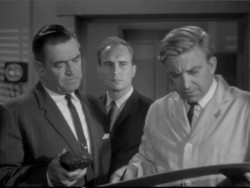 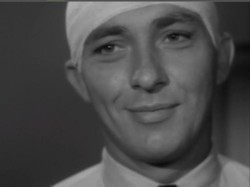 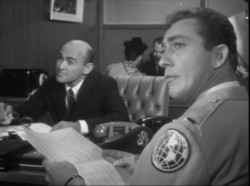 Ballard discusses the meteor fragments with scientists, while Minns decides its time to leave the hospital. A nurse comes in to stop him, and we see for the first time that he can control people's minds. He goes to a commodity broker's office, and in the space of a week earns more than $400,000. Which he divides and sends to his three fellow soldiers, who are in far flung corners of the world working on projects of their own.
Ballard discusses the meteor fragments with scientists, while Minns decides its time to leave the hospital. A nurse comes in to stop him, and we see for the first time that he can control people's minds. He goes to a commodity broker's office, and in the space of a week earns more than $400,000. Which he divides and sends to his three fellow soldiers, who are in far flung corners of the world working on projects of their own.
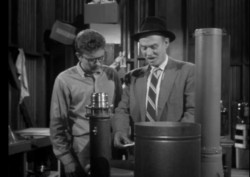  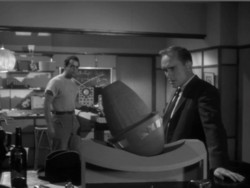
Dee Pollock played Francis Hadley, P.F.C, who was actually located in Wichita, and purchases a building where he is conducting certain experiments. Ivan Dixon plays Sgt. James Conover, who is about to return to a German lab where he's been working, only to realize that Ballard is within. Ballard also visits Tokyo, where James Frawley as Robert Renaldo is working on an anti-gravity device. Renaldo tells Ballard that "Charlie" is in head, and he can't resist. Ballard wants Renaldo to come with him.
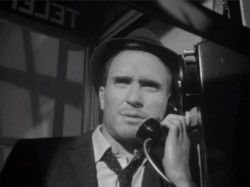 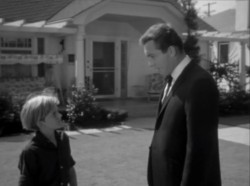 
Ballard comes back to his senses a couple of days later. He'd been at a racetrack...with no memory of how he got there. Meantime, Minns walks past a house when a young boy runs out of it and up to him. "Lieutenant, you're going to take me with you, aren't you? "Yes," says Minns.
Minns returns to his apartment. Ballard, Harris, and a few private detectives have the place staked out. Minns senses this, but walks into the building anyway.
"The Inheritors", Part 2
Ballard and Harris and a group of detectives have Minn's apartment building staked out. Ballard and Harris enter the apartment, and instruct two detectives to wait outside. If Minns tries to leave, they are to shoot him wtihout compunction. Ballard finds a pad with some cryptic notes on it, and he copies them down. Then Minns returns.
Minns confirms that he knew the men were in the apartment. Ballard tells him to fight the beings controlling him, but Minns says he can't, "anymore than you can fight me."
He goes to the desk to get the notes from the pad.
  
Ballard tells him not to move. Not to turn and look at them, or they'll shoot. Not to go out the door. "I don't want anyone hurt," says Minns. "That's fine," says Ballard. "Then just come with us." Minns opens the door. Harris shoots, to no avail. The two guards outside shoot at point blank range, to no avail. Minns spares one look back into the room, then walks away.

 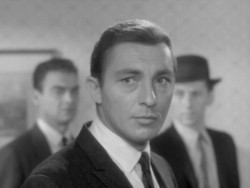
Conover and Renaldo arrive at the building in Wichita where they are constructing the spaceship. Lots of discussion about how smart they find themeslves, what each one of them is doing to construct the spaceship (Conover had the parts made in Germany, Renaldo did anti-gravity device, and so on.) They don't know why they're doing what they're doing, and they're scared. Meantime, Harris has deciphered the meaning of the cryptic notes, and Ballard goes investigating, to find that Minns is recruiting handicapped children.

 
Hanley arrives, with his contribution to the project. The police let him enter. Ballard and Harris and the guards follow him into the building and see the space ship.

 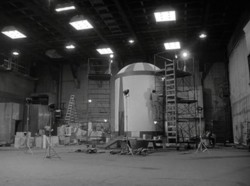
A force field is turned on. The officials try a variety of weapons, but nothing will penetrate it. Meanwhile, Minns goes about collecting the children. Then he heads for Wichita. Roadblocks can't stop them, a forcefield protects the car.
  
Ballard knows that there's nothing he can do. He begs the three men to fight against their controllers, to turn off the forcefield. Then Minns arrives with the children. Ballard demands to know why the children are being taken. Are they going to be used for some experiment. Again he begs the three men to fight against their control and turn off the forcefield.
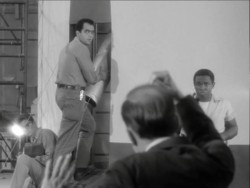  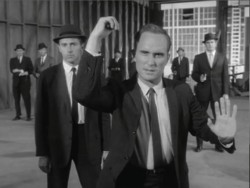
Minns helps the children into the spaceship. Ballard, more and more desperate, begs the rest of the men to turn off the forcefield. And they are beginning to agree. They pepper Minns with questions, angrily.
   Minns suddenly begins receiving words in his mind. He tells what the aliens have in mind. The aliens were a long lived race, but a terrible blight came on the planet, and they were no longer able to have children. So, they sent out meteorites, filled with their RNA, in the hopes that one would land on a planet similar to their own. And one of those meteorites found its way to Earth. These children were chosen, not because they were helpless, but because they were hopeless. On their new planet, they will be the inheritors of a bright new world.
Minns suddenly begins receiving words in his mind. He tells what the aliens have in mind. The aliens were a long lived race, but a terrible blight came on the planet, and they were no longer able to have children. So, they sent out meteorites, filled with their RNA, in the hopes that one would land on a planet similar to their own. And one of those meteorites found its way to Earth. These children were chosen, not because they were helpless, but because they were hopeless. On their new planet, they will be the inheritors of a bright new world.
Ballard points out that he can't let the children be taken. Minns tells his associates to turn off the forcefield. "In that case, go in and get them." Ballard and Harris enter the spacecraft, to find out that its atmosphere is such that all of the children have been made healthy and whole. It's the same atmosphere that's on the planet they're going to.
  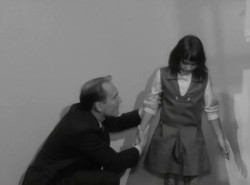
Ballard and Harris exit the rocketship, stunned and impressed. Next, Minns asks the other three men if they want to accompany the children on the journey. They all say yes. Camera pulls back and... fade out.
 

1965-1966
In 1965, Ihnat continued to work steadily on TV. He worked in his first Gunsmoke episode and had a role in a Honey West ep, to name but two. In 1966, he got to beat up Marlon Brando in The Chase, and had a few memorable guest-star turns on TV, including the first guest-star in the first episode of The Iron Horse, his first The F.B.I., and a return to Gunsmoke.
In Like Flint (1967)
James Coburn had been a success as Derek Flint in the spy spoof Our Man Flint in 1966. So popular had it been that In Like Flint was rushed into production for the next year. It was not a very good film, unfortunately, and the Derek Flint franchise ended right there.
A group of middle-aged women attempt to take over the world by a variety of means, including brainwashing women using hair-dryers, replacing the President of the United States with a look-alike, and taking over a floating space platform from which to dictate their will, or destroy large sections of the planet.
  
Ihnat plays General Carter, who betrays the US to help the women with their goal, and then betrays them so that he can rule the world. Although Ihnat does an excellent job as Carter -- as he does with all his villains -- he simply is not given enough screen time to make a memorable villain. His "schtick" is to order his soldiers about with his swagger stick, and he gets to whap Coburn/Flint up the side of the face with it, but the final battle on the space station is shot as if it took place in weightless gravity, and is hardly a memorable fight.
Ihnat and Coburn would become good friends, however, and Coburn would star in Ihnat's film The Honkers (which would be released posthumously.)
Countdown (1968)
In 1968, Steve continued to be busy on the small screen, and appeared in three movies - as the villain in Kona Coast, as the pschopathic Barney Benesch in the first and last scenes of Madigan, and a slightly larger role in Countdown.
Steve plays Ross Duellen, the project manager for the project to get a US astronaut onto the moon before the Russians beat them to it. Here he again works with Robert Duvall.
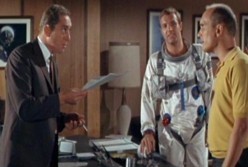  
Countdown, directed by Robert Altman, is "near" science fiction. All of the technology involved is what the United States had at the time, save for the final shelter idea which is what is supposed to be used to beat the Russians. James Caan and Robert Duvall play rival astronauts, each of whom wants to step foot on the moon first. (Michael Murphy plays the third astronaut of the triumverate, who is not given much screen time.)
Hearing the news that the Russians are going to beat them to the moon, the powers that be at NASA decide to send Caan, and a shelter separately, on a one-way trip to the Moon. Caan will wait there until Apollo is ready to pick him up...whenever that might be.
Altman disowned the movie, as the studio changed the ending on him. He had wanted a downbeat ending - Caan is never able to find the shelter, and ends up dying (as did the Russians who do land before him.) However, the studio changes it so that the last shot is of Caan seeing the red light of the shelter, and walking toward it.
The audience still never finds out if Apollo manages to reach him in time.
Steve is excellent in his role as the hard-driving, perfectionist project manager, who is willing to risk the lives of his astronauts to get his job done. He has considerable screen time, until Caan and his adventures on the moon take over the last portion of the movie. He also holds his own with Robert Duvall, Charles Aidman, and Ted Knight, with whom his character locks horn at various points throughout the film.
1969
1969 was another busy year for Steve Ihnat. He starred as Stefan Miklos in what is considered to be one of the seminal Mission Impossible episodes, "The Mind of Stefan Miklos." He also played Gus Kellar in what is considered to be a seminal Mannix episode, "Endgame." He also was practically unrecognizable as Four-Eyes in the "Last Grave at Socorro Creek," and it wasn't just because of the obscuring eyeglasses he wore. His posture, his voice, his mannerisms were all unique.
And he also had a star turn as Garth of Izar in Star Trek's "Whom God's Destroy."
Take a quick jump to Garth of Izar in Star Trek's "Whom Gods Destroy."
|


